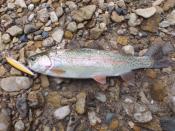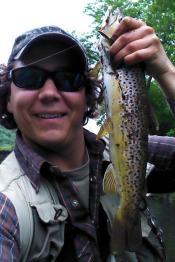Trout fishing is what I grew up with, and with stream conditions the way they are, I felt a need to check out some old stomping grounds. Like so many things in our youth, trout fishing for me was something I got my “fill” of and didn’t really come back to; at least in the same way I did before. We called it “trout-fishing” back then, but at the start it was more about freedom. Even though our parents took us down to the “cricks” (I still call them all by that name), we got to roam up and down the banks, throwing red-and-white bobbers with worms into snags we certainly shouldn’t have. Talk about a frustrating place to learn how to cast. Especially with two younger brothers that always seemed to be standing right behind you on what was left of the already-too-small sandbar.
Though we went “trout-fishing” many times a spring/summer, I don’t think I actually caught one until I was almost 8 years old or so. There weren’t that many great trout streams in our region then, and in all honesty we had as much fun catching chubs, daring each other to mess with snapping turtles, and skipping rocks as we would’ve tangling with a brown anyway.
 When I did get bit by the bug, I spent quite a bit of time fully-exploring the sport. At first, we fished live bait in deep pools, eventually working our way through most types of artificial baits for more agressive stocked fish. After college I spent some time out west, took up fly-fishing, and even did some overflow guiding in Yellowstone for a buddy who was a more formal “guide.” Minnesota cricks were always better suited for a short but stout spinning rod, old tennis shoes, and more determination than sophistication. Which is how I headed down to fish those same fish of my youth once more. Armed with a wealth of knowledge from all who have shared some with me over the years, I reconnected with the fishes of years gone by if only for a few hours.
When I did get bit by the bug, I spent quite a bit of time fully-exploring the sport. At first, we fished live bait in deep pools, eventually working our way through most types of artificial baits for more agressive stocked fish. After college I spent some time out west, took up fly-fishing, and even did some overflow guiding in Yellowstone for a buddy who was a more formal “guide.” Minnesota cricks were always better suited for a short but stout spinning rod, old tennis shoes, and more determination than sophistication. Which is how I headed down to fish those same fish of my youth once more. Armed with a wealth of knowledge from all who have shared some with me over the years, I reconnected with the fishes of years gone by if only for a few hours.
 Stream conditions right now are just how I like to fish them. High enough to get good depth in the pools, and fast enough to create lots of nooks, crannies, and current breaks that’ll hold trout of all shapes and sizes. They key point however is that conditions are clearing, but they are not clear. I like fishing water that’s plenty clear, but not crystal. Later in the summer it’ll become a deep pool game, but right now there’s alot more fish-able water, and more trout to consequently give you looks. These small cricks are constantly eroding and slumping their banks, creating some very temporary structure in the form of basketball-sized streambank chunks with vegetation still on them. Most of the fish we caught were using these pieces of structure as current breaks, and it’s not surprising that they were in deeper water outside bends where the bank was slumping in the first place. Fish that came from timber actually came shallower than I’m used to. Later on as water levels subside, piled up timber in big holes makes for a great big-fish program, but for right now, it’s holding fish about everywhere because of how high the water is. For the traditional pools at the bottom of good runs, I saw a great number of fish towards the very downstream-most tail of the hole. Most of those fish were ultra-aggressive, but swifter water requires them to be.
Stream conditions right now are just how I like to fish them. High enough to get good depth in the pools, and fast enough to create lots of nooks, crannies, and current breaks that’ll hold trout of all shapes and sizes. They key point however is that conditions are clearing, but they are not clear. I like fishing water that’s plenty clear, but not crystal. Later in the summer it’ll become a deep pool game, but right now there’s alot more fish-able water, and more trout to consequently give you looks. These small cricks are constantly eroding and slumping their banks, creating some very temporary structure in the form of basketball-sized streambank chunks with vegetation still on them. Most of the fish we caught were using these pieces of structure as current breaks, and it’s not surprising that they were in deeper water outside bends where the bank was slumping in the first place. Fish that came from timber actually came shallower than I’m used to. Later on as water levels subside, piled up timber in big holes makes for a great big-fish program, but for right now, it’s holding fish about everywhere because of how high the water is. For the traditional pools at the bottom of good runs, I saw a great number of fish towards the very downstream-most tail of the hole. Most of those fish were ultra-aggressive, but swifter water requires them to be.
Though I’d spent quite a bit of time fishing lots of different artificials for trout, I had yet to spend much time throwing cranks at them. Always thought they were too big, and for the streams we fished, most of the bigger fish were pooled-up deeper than we could get those baits to run anyway. Later in the day we’d found some success, but we were usually required home far earlier than when the fish always bit.
 I spent some time throwing gold/black varieties of #7 and #9 Original Floating Raps, along with a Husky Jerk in the smallest sizes. The more erratic, the more looks I’d get, but the swift water made hookups difficult as the fish would often miss. Just like a dry fly can get fish to rise for later targeting, a buddy and I used this to our advantage in fishing spinners. I’d make ’em, he’d rake em. I was continually surprised how 10-12″ smaller rainbows would so readily take a larger Rapala, along with some nicer fish too.
I spent some time throwing gold/black varieties of #7 and #9 Original Floating Raps, along with a Husky Jerk in the smallest sizes. The more erratic, the more looks I’d get, but the swift water made hookups difficult as the fish would often miss. Just like a dry fly can get fish to rise for later targeting, a buddy and I used this to our advantage in fishing spinners. I’d make ’em, he’d rake em. I was continually surprised how 10-12″ smaller rainbows would so readily take a larger Rapala, along with some nicer fish too.
That day however, the spinner shined, but not all are created equal we found. I’m a fan of Rooster-Tails and inline Panther Martins, which were tried, but we kept running into the same dilemma. The larger baits were needed to stay down in current, but unlike the Raps, larger spinners were shunned. We found a Vibrax Bullet Fly in sizes 0 and 1 to be the perfect combination of size/weight, especially size 1. These spinners fished heavier, and though I didn’t know it at the time, are 30% heavier for equal sized spinners. Color didn’t matter as much, though Gold/Green did take most of our fish, but the bait needed to be the right size without being too large. Most importantly, you could fish it slowly, deep, and let the current turn those blades. Few fish that I’d raise on the Floating Raps did not hit that spinner when a good presentation was possible.
As is always the case, I re-learned some of what I had forgotten, and spent some time forgetting the unimportant things in life. I know I’ll be fishing this 1-2 punch more frequently when with a friend, as it’s a great system to move fish into revealing their location without spooking them.
Joel